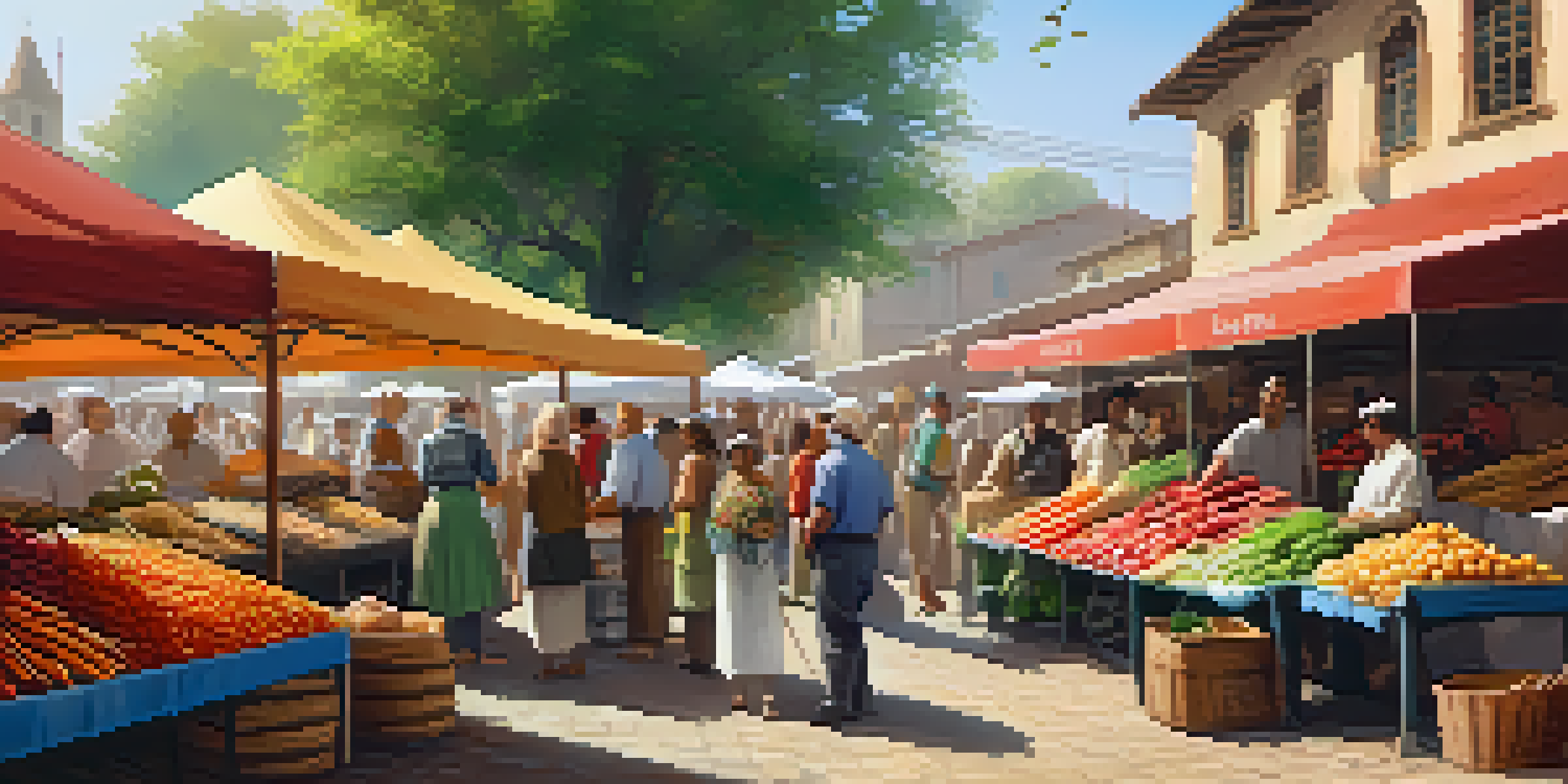Culinary Tourism: Exploring Local Flavors and Experiences

What is Culinary Tourism and Why It Matters
Culinary tourism is more than just eating; it's about experiencing a culture through its food. It allows travelers to immerse themselves in local traditions, flavors, and cooking techniques. By exploring regional cuisines, you can gain insights into a community's history and social fabric.
Food is our common ground, a universal experience.
Every dish tells a story, from the ingredients sourced from local farms to the recipes passed down through generations. This connection between food and culture not only enriches your travel experience but also supports local economies and fosters sustainability.
As culinary tourism grows in popularity, it encourages chefs and home cooks alike to innovate while preserving their culinary heritage. It's a delicious way to explore the world, one bite at a time!
The Rise of Local Food Experiences
In recent years, there's been a significant shift towards local food experiences, driven by a desire for authenticity. Travelers are increasingly interested in eating where locals eat and discovering hidden gems rather than mainstream restaurants. This trend elevates the dining experience, making it more personal and memorable.

Local food experiences can range from farm-to-table dinners to street food tours, offering a taste of everyday life. Cooking classes and workshops also provide hands-on opportunities to learn about regional ingredients and cooking methods. These experiences not only satisfy your palate but also create lasting memories.
Culinary Tourism Enriches Travel
Culinary tourism allows travelers to experience local cultures through food, supporting economies and sustainability.
As you embark on your culinary journey, keep an open mind and be willing to try new flavors. You may discover that the most delicious meals are often found in the most unexpected places!
Exploring Regional Flavors: A Journey Through the Palette
Every region boasts its own unique flavors that reflect its geography, climate, and culture. For instance, coastal areas often feature fresh seafood seasoned with local herbs, while inland regions may highlight hearty meats and root vegetables. Understanding these regional characteristics can enhance your culinary tourism experience.
Traveling – it leaves you speechless, then turns you into a storyteller.
Visiting markets is an excellent way to get acquainted with local ingredients. Here, you'll find vibrant produce, artisanal products, and spices that tell the story of the area's culinary identity. Engaging with local vendors can also provide insights into traditional cooking techniques and recipes.
As you sample different dishes, take note of how flavors evolve from one region to another. This exploration can transform your understanding of global cuisines, making each meal an adventure in taste and culture.
The Role of Food Festivals in Culinary Tourism
Food festivals are a vibrant celebration of local cuisine, bringing communities together and attracting visitors from afar. These events showcase the best of regional flavors, offering a platform for local chefs, farmers, and artisans to share their creations. Attending a food festival can provide a rich, immersive experience that highlights the essence of a culture.
Festivals often feature cooking demonstrations, tastings, and competitions, allowing you to witness culinary arts in action. It's a fantastic opportunity to learn about traditional cooking methods and even pick up a few tips for your own kitchen. Plus, the festive atmosphere makes trying new foods a joyful experience.
Local Food Experiences Thrive
The shift towards local food experiences emphasizes authenticity, with travelers seeking hidden gems and unique flavors.
Whether it's a chili cook-off or a gourmet food fair, these gatherings foster community spirit and pride in local culinary traditions. Participating in a food festival can deepen your appreciation for the region's culinary landscape.
Cooking Classes: A Hands-On Approach to Local Cuisine
One of the most engaging ways to dive into a culture is through its cooking classes. These experiences not only teach you how to prepare traditional dishes but also provide context about the ingredients, tools, and techniques used. From pasta-making in Italy to sushi rolling in Japan, cooking classes offer a fun, interactive way to learn.
Many classes are led by local cooks or chefs who share their culinary secrets and personal stories. This connection often enhances your understanding of the dish's significance within the culture. It's like having a local friend guiding you through the culinary landscape.
Additionally, cooking classes often culminate in a shared meal, allowing you to savor the fruits of your labor. Enjoying the dishes you've prepared with fellow participants creates a sense of camaraderie, making the experience even more enjoyable.
Unique Dining Experiences: Beyond the Plate
Culinary tourism isn't just about the food; it's also about the environment in which you enjoy it. Unique dining experiences, such as dining in a historic building, at a rooftop restaurant, or even a dinner cruise, can elevate your meal to something truly special. These settings can enhance the flavors of the dishes you're enjoying.
Moreover, themed dining experiences, such as medieval feasts or farm dinners, can provide insight into local traditions and history. These imaginative concepts often create a multi-sensory experience that goes beyond taste, engaging sight, sound, and even smell.
Sustainable Eating Matters
Choosing sustainable dining options fosters a connection to local communities and encourages responsible food sourcing.
When choosing dining options, consider how the atmosphere complements the meal. A beautiful view or unique setting can transform a simple meal into an unforgettable experience.
Sustainable Culinary Tourism: Eating with Purpose
Sustainable culinary tourism focuses on responsible eating and supporting local communities. By choosing to dine at farm-to-table restaurants or participating in eco-friendly food tours, you contribute to sustainable practices that benefit both the environment and local economies. This approach not only enhances your travel experience but also aligns with a growing consciousness about food sourcing.
Many chefs are now prioritizing local, seasonal ingredients, creating dishes that reflect the region's bounty while minimizing their carbon footprint. This commitment to sustainability fosters a connection between diners and the food they consume, reminding us of the importance of supporting local producers.

As you explore culinary tourism, think about the impact your choices have on the environment and local communities. Eating with purpose enriches your travel experience and leaves a positive mark on the places you visit.